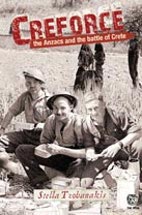Creforce: the Anzacs and the Battle of Crete by Stella Tzobanakis

Black dog books, 2010.ISBN 9781742030821
Middle school. Non Fiction. The story of the German occupation of Crete and the evacuation of
thousands of Australian, New Zealand and British troops, leaving many
behind, is recreated in this easily digested book from a Greek
Australia, who visiting Crete, was enthralled when she saw cemeteries
with English names. Asking questions and then researching, Stella
Tzobanakis discovered the little known history of the links between
Crete and Australia and New Zealand, forged when the people of Crete
supported those troops left on the island, and they in turn, helped the
resistance movement undermine the German occupying force.
The details with which the author tells the story of the German
invasion of Crete in May, 1941, is intoxicating, as we hear of the
paratroopers dropping from the sky, the lack of armaments of the Anzac
forces repatriated to Crete, the incredible bravery of small groups of
men, the sacrifice of some of the people of Crete in trying to save
their homeland. With staggering lists of numbers killed, wounded,
evacuated, left on the island, in the battalions and so on, the story
is lifted from the straight historical record to an exciting account of
the dangers each group faced. The story of the evacuation of the allied
troops is a story in itself, with a Dunkirk like flotilla of ships
taking the men from Crete to Egypt. Submarines were loaded beyond
capacity to get the men off, and the ones left behind fled to the
hills, where they were helped by local people, or were captured by the
Germans. Some allied soldiers captured were taken to the POW camps in
Germany and Czechoslovakia, while others remained incarcerated in
Crete. Those left on the hills harried the German occupiers, and
with help from MI9, supplies were dropped to give assistance to them
and the guerilla forces.
Ably supported with maps, statistics, personal stories and pictures,
this book, part of black dog book's excellent series, The Drum,
will
find a readership amongst those students looking at the Anzacs, or
Australia's involvement in war, or at the relationship between Crete
and Australia. After the war several Cretan brides came to
Australia to join their husbands and the post war migration boom saw
160,000 Greece-born people arrive in Australia, nearly half taking up
residence in Melbourne. These included many from Crete.
Fran Knight